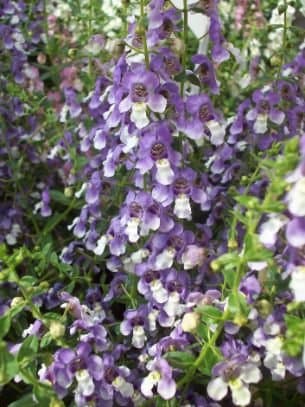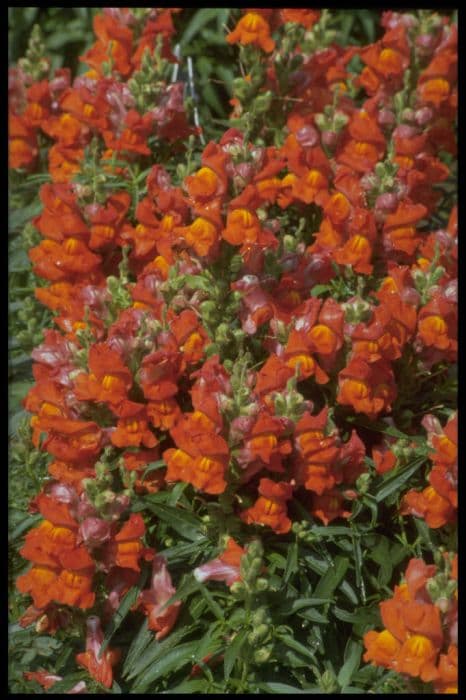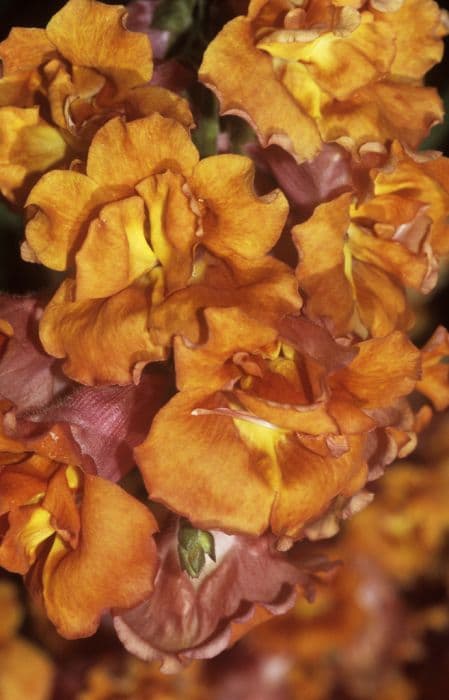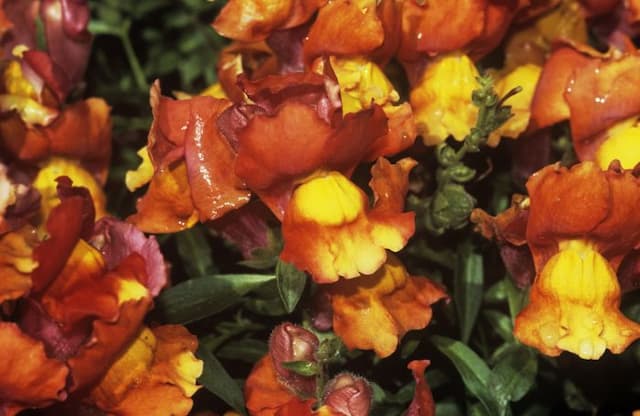Snapdragon Antirrhinum majus 'La Bella Pink' (La Bella Series)

ABOUT
The 'La Bella Pink' Snapdragon is part of the La Bella Series and is known for its captivating floral display. The plant is adorned with tall spikes that carry clusters of large, tubular flowers, each blossoming in a vivid shade of pink. These flowers have a characteristic dragon-like face, which is where the common name 'Snapdragon' comes from, as they resemble a dragon's mouth that opens and closes when lightly squeezed. The blooms are densely packed along the spikes and can cover much of the plant’s upper portion when in full bloom. The petals have a velvety texture and may exhibit subtle variations in pink hues, providing a gradient of color that enhances the plant's visual appeal. The foliage of the 'La Bella Pink' Snapdragon consists of medium green leaves that are lance-shaped, with a slightly pointed tip and arranged in a spiraling pattern around the stem, giving the plant a lush, full appearance. The foliage offers a nice contrast against the bright pink blossoms. This Snapdragons cultivar is grown for its showy flowers and is popular for use in garden beds, borders, and as cut flowers due to their striking beauty and long stems. Overall, the 'La Bella Pink' Snapdragon brings a burst of cheery pink color to any planting and is beloved for its charming flowers that add a touch of whimsy to the setting.
About this plant
 Names
NamesFamily
Plantaginaceae
Synonyms
Snapdragon, Dragon Flower
Common names
Antirrhinum majus
 Toxicity
ToxicityTo humans
Snapdragon, the most common name for Antirrhinum majus, is not considered highly toxic to humans. However, ingesting large quantities of any plant may cause gastrointestinal discomfort, such as stomach pain, nausea, vomiting, or diarrhea. It's advisable to keep snapdragon plants out of the reach of small children who may be tempted to eat them, as with any non-food plant.
To pets
Snapdragon is generally not considered toxic to pets. It is not listed as a poisonous plant for animals such as cats and dogs. Ingesting snapdragons might cause mild gastrointestinal upset in some pets, potentially resulting in symptoms such as vomiting or diarrhea if they consume large amounts. However, these reactions would be relatively rare. If your pet shows signs of distress after eating any plant, it is always best to consult a veterinarian.
 Characteristics
CharacteristicsLife cycle
Annuals
Foliage type
Deciduous
Color of leaves
Green
Flower color
Pink
Height
1-3 feet (30-91 cm)
Spread
1-2 feet (30-61 cm)
Plant type
Herb
Hardiness zones
9
Native area
Mediterranean
Benefits
 General Benefits
General Benefits- Attracts Pollinators: Snapdragons are known to attract bees and butterflies, which are beneficial for pollination in gardens.
- Colorful Blooms: 'La Bella Pink' snapdragons provide vibrant pink flowers that add a splash of color to gardens and landscapes.
- Extended Flowering Period: This variety tends to have a long blooming season, offering aesthetic appeal over an extended period.
- Easy to Grow: Snapdragons are generally easy to cultivate and can thrive in a variety of soil conditions with proper care.
- Versatility: These plants can be used in garden beds, borders, containers, and as cut flowers for indoor displays.
- Drought Tolerance: Once established, snapdragons can tolerate short periods of drought, making them suitable for different climate conditions.
- Deer Resistance: Snapdragons are not a preferred food source for deer, which can help to maintain their beauty in areas with deer populations.
- Cold Tolerance: 'La Bella Pink' snapdragons can withstand cooler temperatures and may be planted in early spring or fall in many regions.
 Medical Properties
Medical Properties- This plant is not used for medical purposes.
 Air-purifying Qualities
Air-purifying QualitiesThis plant is not specifically known for air purifying qualities.
 Other Uses
Other Uses- Photography and Art: Snapdragon's distinct shape and vibrant colors can be used as inspiring subjects for photographers and artists looking to capture the beauty of nature.
- Educational Tool: Teaching plant biology or botany classes often uses snapdragons as an example for discussions about plant structure, pollination, and genetic inheritance due to the flower's intriguing morphology.
- Eco-Friendly Confetti: Dried snapdragon petals can be used as a biodegradable alternative to traditional confetti at celebrations, reducing environmental impact.
- Floral Arrangements: Snapdragon stems can add height and structure to floral arrangements, making them a popular choice among florists for bouquets and centerpieces.
- Hobby Gardening: Gardeners enjoy cultivating snapdragons for the joy of nurturing something beautiful and the challenge of raising them in different climates.
- Natural Dye: The vibrant petals of some snapdragon varieties may be used to create natural dyes for fabrics or crafts.
- Edible Garnish: Although not commonly consumed, snapdragon flowers are edible and can be used as an attractive garnish for salads and desserts.
- Garden Design: Snapdragons can be used to inject seasonal color into garden beds, borders, or as part of a cottage garden planting scheme.
- Floral Crafts: Snapdragon flowers and seed pods can be incorporated into craft projects like making flower crowns, wreaths, or dried flower arrangements.
- Seasonal Festivities: Snapdragons can be included in seasonal decorations, such as autumnal displays or springtime table settings, due to their diverse color range and distinctive shape.
Interesting Facts
 Feng Shui
Feng ShuiSnapdragons are not used in Feng Shui practice.
 Zodiac Sign Compitability
Zodiac Sign CompitabilitySnapdragons are not used in astrology practice.
 Plant Symbolism
Plant Symbolism- Deception and Grace: Snapdragons are often associated with both deception and grace due to their unique flower shape which can appear like a dragon's mouth when squeezed, thus being able to "deceive" the eye, while still maintaining an elegant appearance.
- Strength and Protection: In some folklore, snapdragons were thought to offer protection and were planted near gates and entryways. They symbolize inner strength to stand firm against adversity.
- Resilience and Rebirth: Snapdragons can thrive in challenging conditions, symbolizing the ability to recover and start anew after difficulties or to symbolize a fresh start.
- Love and Affection: Due to their vibrant colors and appealing aesthetic, snapdragons can also be a symbol of love and affection, expressing a deep and passionate connection.
 Water
WaterSnapdragons prefer consistent moisture, so water them once or twice a week with 1 to 1.5 gallons per watering, depending on climate and soil conditions. During hot, dry periods, increase the frequency to maintain even soil moisture, but avoid overwatering which can lead to root rot. Ensure that the soil is well-draining and that the water reaches deep into the root zone, which promotes strong root development. Reduce watering in the fall as temperatures cool and plant growth slows down.
 Light
LightSnapdragons thrive in full sun to partial shade, ideally receiving at least 6 hours of direct sunlight each day. The best spot for them would be one where they are exposed to morning sunlight and get some protection from the intense heat of the mid-day sun, especially in hotter climates.
 Temperature
TemperatureSnapdragons prefer cooler temperatures and can survive in minimum temperatures as low as 40°F for short periods. They flourish in temperatures ranging from 60°F to 75°F, which are ideal for vigorous growth. They can tolerate temperatures up to 85°F, but prolonged heat can cause the plants to languish.
 Pruning
PruningPrune snapdragons to encourage bushiness and more blooms by pinching off the tops when the plants are young. Deadhead spent blooms regularly to prolong the flowering period and to maintain a neat appearance. Pruning is best done during the growing season, but avoid heavy pruning late in the fall as the plants prepare for dormancy.
 Cleaning
CleaningAs needed
 Soil
SoilSnapdragons like well-draining soil with a slightly acidic to neutral pH of 6.2 to 7.0. A good soil mix for Snapdragons would consist of loamy or sandy soil enriched with organic matter like compost or well-rotted manure to provide nutrients and improve the soil structure.
 Repotting
RepottingSnapdragons generally do not require frequent repotting as they are often grown as annuals. Repotting every year is sufficient if you are keeping them as perennials in containers; ensure the pot provides ample space for growth.
 Humidity & Misting
Humidity & MistingSnapdragons prefer moderate humidity levels but are adaptable to a range of humidity conditions, making them suitable for most garden environments. They do not require special humidity adjustments for optimal growth.
 Suitable locations
Suitable locationsIndoor
Ensure bright light, cool temperature and good air circulation for Snapdragons indoors.
Outdoor
Full sun, well-drained soil, protect from strong winds for Snapdragons outdoors.
Hardiness zone
7-10 USDA
 Life cycle
Life cycleAntirrhinum majus 'La Bella Pink', commonly known as Snapdragon 'La Bella Pink', begins its life cycle as a seed, which germinates in warm, moist soil, typically in the spring. After germination, the seedling emerges and establishes a root system while developing leaves during the vegetative growth stage. The plant then enters the flowering stage, where it produces tall spikes adorned with large, pink, tubular flowers that are attractive to pollinators. Following pollination, the flowers develop into fruit capsules containing seeds that mature and are eventually released. If conditions are favorable, these seeds can give rise to new plants, completing the cycle. In some climates, Snapdragons may behave as perennials, entering a dormant phase in winter and resuming growth in spring; otherwise, they are treated as annuals or biennials, completing their life cycle within one or two growing seasons, respectively.
 Propogation
PropogationPropogation time
Spring-Early Summer
The most popular method for propagating Antirrhinum majus 'La Bella Pink', commonly known as Snapdragon, is through seeds. Snapdragons are typically sown in late winter or early spring, allowing them to become well-established before being planted out after the risk of frost has passed. To propagate, the tiny seeds are scattered on the surface of a moist, well-drained seed starting mix and gently pressed into the surface, as they require light to germinate. The potting container should then be placed in a warm spot, between 65 to 70 degrees Fahrenheit (18 to 21 degrees Celsius), and kept consistently moist. Seedlings usually appear within two to three weeks, at which point they can be thinned out and eventually planted in their final growing positions once they've developed a set of true leaves and the threat of frost has subsided.









